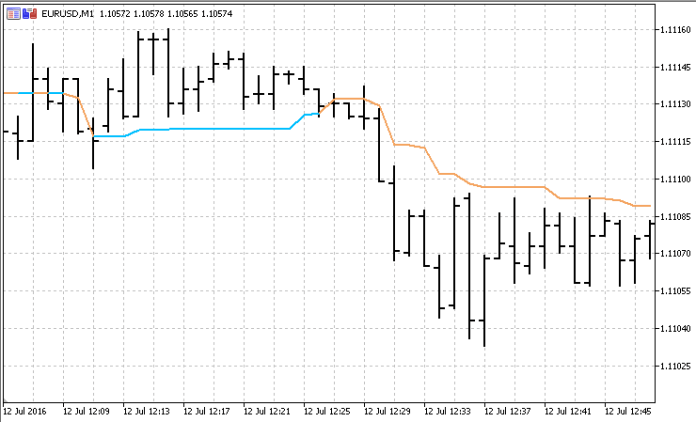Kijun Sen with Alerts Indicator for MetaTrader 5 (MT5). In this article, we’ll delve into the details of this indicator, exploring its significance, functionality, and practical applications. Whether you’re a seasoned trader or just starting, understanding the Kijun Sen indicator can enhance your decision-making process and improve your trading outcomes.
Why is it Important?
The Kijun Sen, also known as the “baseline” in the Ichimoku Kinko Hyo system, plays a crucial role in assessing market trends. Here’s why it’s essential:
- Trend Identification: The Kijun Sen helps identify the prevailing trend. When a price crosses above the Kijun Sen, it signals an uptrend, while a cross below indicates a downtrend.
- Dynamic Support and Resistance: The Kijun Sen acts as a dynamic support or resistance level. Traders often use it to determine entry and exit points.
- Confirmation Tool: When combined with other indicators, the Kijun Sen confirms trend changes and provides additional insights.
How Does it Work?
The Kijun Sen is calculated as the average of the highest high and lowest low over a specified period (usually 26 periods). Here’s how it works:
- Calculation: The Kijun Sen is derived from the midpoint of the Tenkan Sen (Conversion Line) and the Senkou Span B (Leading Span B).
- Color Coding: By default, the Kijun Sen is turquoise during an uptrend and orange during a downtrend.
- Alerts: The indicator can be configured to send alerts when trend changes occur or new bars form.
How to Understand?
Understanding the Kijun Sen involves grasping its role as a trend identifier and dynamic support/resistance level. Pay attention to price crossovers with the Kijun Sen and observe how it interact with other indicators on your chart.
Interpreting Kijun Sen Crosses
When the price crosses above the Kijun Sen, it signals a potential bullish trend reversal or continuation. Conversely, a price crossing below the Kijun Sen indicates a bearish trend. Traders often use these crossovers as entry or exit points. Keep in mind that the Kijun Sen’s lagging nature means that it may not provide immediate signals, so patience is key.
Combining Kijun Sen With Other Indicators
While the Kijun Sen is powerful on its own, combining it with other technical indicators can enhance its effectiveness. For example:
- Ichimoku Cloud: The Kijun Sen is part of the Ichimoku system, which includes other components like the Tenkan Sen and Senkou Span. Using the full Ichimoku Cloud can provide a comprehensive view of market conditions.
- Moving Averages: Overlaying the Kijun Sen with other moving averages (such as the Simple Moving Average or Exponential Moving Average) can help confirm trends and filter out noise.
Risk Management With Kijun Sen
Like any trading tool, risk management is crucial. Here’s how to incorporate the Kijun Sen into your risk management strategy:
- Stop Loss Placement: Set stop-loss orders below the Kijun Sen during uptrends (and above during downtrends) to limit potential losses.
- Take Profit Levels: Consider taking profits when the price approaches the Kijun Sen. This level often acts as a significant support or resistance area.
Backtesting and Optimization
Before fully integrating the Kijun Sen into your trading strategy, conduct thorough backtesting. Use historical data to see how the indicator performs under different market conditions. Adjust the Kijun Sen’s parameters (such as the period) to find the optimal settings for your preferred trading style.
How to Trade with Kijun Sen With Alerts Indicator
Buy Entry
- Wait for the price to cross above the Kijun Sen (baseline).
- Confirm the bullish trend using other indicators or price action.
- Set a buy order when the price closes above the Kijun Sen.
- Place the stop-loss below the Kijun Sen or recent swing low.
- Target the next significant resistance level or use a trailing stop.
Sell Entry
- Wait for the price to cross below the Kijun Sen.
- Confirm the bearish trend using additional analysis.
- Set a sell order when the price closes below the Kijun Sen.
- Position the stop-loss above the Kijun Sen or recent swing high.
- Aim for the next substantial support level or use a trailing stop.
Conclusion
Kijun Sen with Alerts Indicator is a valuable tool for traders. By understanding its mechanics and integrating it into your trading strategy, you can enhance your decision-making process and navigate the markets more effectively. Remember to combine it with other indicators and practice risk management to achieve consistent success.
Recommended MT5 Brokers
XM Broker
- Free $50 To Start Trading Instantly! (Withdraw-able Profit)
- Deposit Bonus up to $5,000
- Unlimited Loyalty Program
- Award Winning Forex Broker
- Additional Exclusive Bonuses Throughout The Year
>> Sign Up for XM Broker Account here <<
FBS Broker
- Trade 100 Bonus: Free $100 to kickstart your trading journey!
- 100% Deposit Bonus: Double your deposit up to $10,000 and trade with enhanced capital.
- Leverage up to 1:3000: Maximizing potential profits with one of the highest leverage options available.
- ‘Best Customer Service Broker Asia’ Award: Recognized excellence in customer support and service.
- Seasonal Promotions: Enjoy a variety of exclusive bonuses and promotional offers all year round.
>> Sign Up for FBS Broker Account here <<
(Free MT5 Indicators Download)
Click here below to download:





